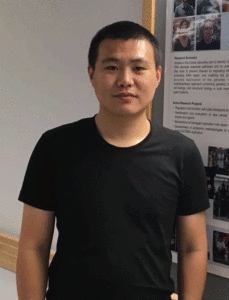DNA replication discovery opens pathways to understanding and treating cancer, aging, and degenerative disease
By Marissa Shapiro
A team of international researchers, led by David Cortez, Richard N. Armstrong, Ph.D. Chair for Innovation in Biochemistry, delved into how cells handle DNA damage and genome instability in a recent paper published in Science, unearthing groundbreaking findings with implications for cancer and disease treatments.
When cells divide, they need to copy their DNA so that both resulting cells have a complete set of genetic information. This copying process occurs at a site called the replication fork, where the DNA double helix unwinds.
Sometimes, DNA replication encounters obstacles such as damage induced by environmental toxins, which may lead to mutations that can cause cancer. In response to these replication obstacles, cells employ a strategy called “replication fork reversal.” During this process, the replication fork pauses and then moves backward, a move that is accompanied by the annealing of the two daughter DNA strands. Fork reversal safeguards the genome by increasing tolerance to the replication obstacles, allowing for accurate DNA repair.
Understanding this process is crucial because it sheds light on how cells can accurately copy their DNA without introducing errors that can lead to diseases like cancer.

Wenpeng Liu, a postdoctoral fellow and the first author of the paper, and team discovered a mechanism that relies on a protein called RAD51. This mechanism allows cells to successfully carry out DNA reversal while dealing with replication stress. The discovery not only completely changes our understanding of how fork reversal works but also solves a mystery that has puzzled researchers for years about how this beneficial process is compatible with the current understanding of replication.
By gaining a deeper understanding of DNA replication, scientists can lay the groundwork for addressing abnormalities that underlie various diseases, and this line of research offers promising avenues for developing more effective therapies. Other collaborators on the paradigm-shifting research included Alessandro Vindigni at Washington University in St. Louis and Masato Kanemaki at the National Institute of Genetics in Japan.
Liu, W., Saito, Y., Jackson, J., Bhowmick, R., Kanemaki, M.T., Vindigni, A., Cortez, D. (2023). RAD51 bypasses the CMG helicase to promote replication fork reversal. Science, 380(6643), 382-387.
New drug type may reduce opioid addiction but keep its pain relief properties
By Alexandra Scammell
Researchers at the Warren Center for Neuroscience Drug Discovery have found that selective blocking of the M5 muscarinic acetylcholine receptor—referred to as mAChR—can influence behaviors during the opioid addiction process without negative impacts to motor function, motivation, or opioid-mediated analgesia—pain relief—in rats. This recent work, led by Carrie Jones, director of in vivo pharmacology and development for the WCNDD and associate professor of pharmacology, and Laura Teal, graduate student in the Jones lab, could provide a new solution to the prevalent problems of opioid misuse and opioid use disorder around the world.

Opioids, such as morphine, fentanyl, and oxycodone, are commonly prescribed to patients to treat pain and are one of the most prescribed drug classes around the world. However, opioid analgesics can be extremely addictive, and the drugs’ continuous use can lead to OUD, among other health issues, and even death due to overdose. According to the Centers for Disease Control and Prevention, there were almost 70,000 opioid-related overdose deaths in 2020, and the rate of these deaths increased by almost 40 percent from 2019 to 2020.
Jones and her colleague Craig Lindsley, executive director of the WCNDD, have been looking for new targets, such as the M5 mAChR, that can diminish the addictive effects of opioid analgesics while still retaining their pain-relieving effects in patients. Together, they have discovered several M5 selective negative allosteric modulators, including VU6008667, the NAM investigated in this study.
In their article, Jones and Teal explored VU6008667 administration in rats to better understand how it affected addiction behaviors, including acquisition, withdrawal, and relapse of oxycodone drug seeking. For the first time, they say, they found that selective blocking of the M5 mAChR subtype lessens oxycodone-seeking behavior in opioid-naive rats over a period of 21 days using M5 NAM VU6008667.
In addition, the acute and chronic administration of VU6008667 had little to no effect on rats’ motivation, motor function, or cognition, and it did not influence withdrawal. Most importantly, VU6008667 did not affect oxycodone-induced analgesia. According to the authors, their results indicate that selective M5 NAMs offer a promising way to prevent opioid misuse and relapse of OUD without unfavorable effects and without altering opioid-induced pain relief.
Teal, L.B., Bubser, M., Duncan, E., Gould. R.W., Lindsley, C.W., Jones, C.K. (2023). Selective M5 muscarinic acetylcholine receptor negative allosteric modulator VU6008667 blocks acquisition of opioid self-administration. Neuropharmacology. 2023;227:109424.
Using fluorescence endoscopy to detect colonic adenomas
By Sarah E. Glass
Detecting adenomas by colonoscopy remains one of the main preventative measures for colorectal cancer, with almost 100,000 adenomas identified during first-time screenings per year in the U.S. Unfortunately, using white-light colonoscopy—the clinical standard—without probing for a particular molecular marker of adenomas can lead to 30% of lesions going undetected.

Md. Jashim Uddin, research associate professor of biochemistry, Larry Marnett, Mary Geddes Stahlman Professor of Cancer Research and university distinguished professor of biochemistry, and colleagues chose to use cyclooxygenase-2 or COX-2, an enzyme that increases inflammation and that is upregulated in preneoplastic lesions and colorectal cancer, as the marker to target when developing a fluorescent imaging agent to improve adenoma detection.
This work, reported in the Journal of Biomedical Optics, signifies an advance in adenoma detection by colonoscopy, which could reduce the number of colorectal cancer cases considering that adenomas, precursor lesions, can be removed during colonoscopies.
In 2010, the researchers discovered a fluorescent inhibitor of COX-2 called fluorocoxib A; it was the first COX-2-targeted molecular imaging agent for the in vivo fluorescence imaging of inflammation and cancer and has since been widely used in research in the U.S. and across the globe. Now, the authors sought to forge a path to the clinic and packaged fluorocoxib A into an FDA-approved polymer to improve delivery to the adenomas.
Uddin and colleagues administered fluorocoxib A to mice before a colonoscopy, which allowed them to clearly identify colonic adenomas in mice containing elevated levels of COX-2 in the lesions. The colon tissues of normal mice were not illuminated with the fluorescent compound, indicative of the lack of lesions. Pre-dosing the mice with a non-fluorescent inhibitor of COX-2 or with a fluorescent molecule that does not inhibit COX-2 led to minimal labeling of adenomas.
Packaging the COX-2 inhibitor in the FDA-approved polymer creates a tractable path for clinical trials that could ultimately impact adenoma detection for the millions who undergo colonoscopies every year across the country.
Uddin, M.J., Niitsu, H., Coffey, R.J., Marnett, L.J. (2023). Development of Pluoronic nanoparticles of fluorocoxib A for endoscopic fluorescence imaging of colonic adenomas. J Biomed Opt. 2023;28(4):040501.
A new framework synergizes basic and translational alcohol use research
By Alexandra Scammell
Consumption of alcohol is popular worldwide due to its euphoric effects. However, the abuse of alcohol is also a global problem, resulting in around three million deaths each year. In the United States alone, nearly 30 million people suffered from alcohol use disorder in 2020, according to the 2021 National Survey on Drug Use and Health.

Cody A. Siciliano, assistant professor of pharmacology, and Alex R. Brown, former lab manager of the Siciliano lab, and other members of the Vanderbilt Center for Addiction Research have designed a novel method of tracking alcohol reinforcement that addresses the ongoing difficulty of integrating basic and translational alcohol research. This flexible framework can aid in the eventual development of therapeutic interventions for AUD.
Significant research effort is devoted to understanding how alcohol acts on the brain and body using nonhuman model species. These efforts span a wide range of disciplines, from biochemistry and toxicology to neuroscience and psychology, and represent both basic and translational research questions. Despite the diversity of alcohol research, little effort is put toward integrating findings from different subfields, even as these lines of research often exist in parallel. For example, basic research into how alcohol binds to certain receptors may use non-overlapping terminology with translational research aimed at testing whether pharmacotherapeutics targeted to certain receptors decrease alcohol consumption. The lack of synergistic frameworks for understanding and reporting alcohol’s effects undoubtedly account for a number of missed opportunities and breakthrough discoveries.
In answer to these challenges, the VCAR scientists created a better method to ease collaboration between basic and translational AUD researchers. As explained by the study authors, “basic investigations require flexibility of experimental design as hypotheses are rapidly tested and revised, whereas preclinical [translational] models emphasize standardized protocols and specific outcome measures.”
Their new method, called Structured Tracking of Alcohol Reinforcement or STAR, provides a quantitative framework for assessing alcohol drinking behaviors in animals. STAR uses a phenotyping analysis to group subjects into “low drinker,” “high drinker,” and “compulsive drinker” categories based on differences in alcohol intake and their tendencies to continue to consume alcohol even when drinking was punished with a negative outcome (in this case, the punishment was adding quinine to the alcohol, which gives it a bitter taste and causes most mice, but not all, to reduce their drinking).
Once categorized, STAR imposes minimal constraints on experimental design, allowing for researchers to make alterations as needed for specific questions. Importantly, the authors show that once mice have established their preferences for alcohol, they remain in the same drinking category over several months of repeated testing. Thus, by reporting findings within this framework, researchers can retain conceptual continuity without sacrificing experimental flexibility. By bridging subfields, the STAR framework promises to synergize efforts across diverse areas of alcohol research.
Brown, A.R., Branthwaite, H.E., Farahbakhsh, Z.Z., Mukerjee, S., Melugin, P.R., Song, K., Noamany, H., Siciliano, C.A. (2023). Structured tracking of alcohol reinforcement (STAR) for basic and translational alcohol research. Molecular Psychiatry, 28, 1585– 1598.